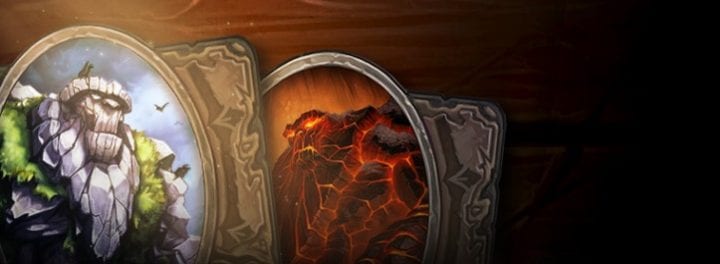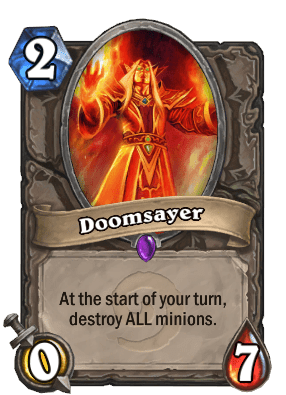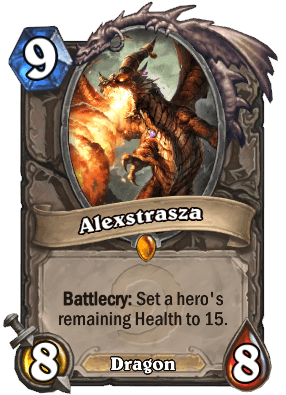
The 10 Best Decks for Hearthstone’s New Classic Mode
by hsdecktech - 3 years ago show comments
Hearthstone Classic Mode launched today with Patch 20.0, the Mode that brings us back to 2014–the time before expansions and stats websites! For those of you who were not around back then, it is a chance to experience the wonders of early Hearthstone: both the broken and the quaint. For those of us who were around, it’s a trip down memory lane and and chance to see how things really stack up with the benefit of hindsight.
Since there were no deck trackers back then, the public never received any statistical information on what was good or bad on the ladder. The best we got was tournament reports and forum posts. Which is to say that there’s a lot of uncertainty about how all the “best” decks at the time actually stacked up. So, if you’re looking for something to try out today, here are the decks that shaped that early meta–today’s the day to find out if they’re any good!
Force-Roar Druid
Starting alphabetically with Druid (there was no Demon Hunter at the time), we start with the deck that we have since heard from Blizzard to have been secretly perhaps the strongest of the time. Force-Roar Druid refers to the the cards Force of Nature (which back then cost one more but the Treants had Charge) and Savage Roar, a combination that provided 14+ burst damage from hand at 9 mana. The deck also had un-nerfed ramp–both Innervate and Wild Growth–to more easily get to that 9, and solid tempo plays along the way. You’ll be shocked to learn that back in the early days of Hearthstone there was a lot of disagreement as to whether you even wanted to play Force-Roar in your Druid decks and, if you did, how many copies of each. In hindsight, that seems a little silly–play your best cards!
Note: At the time, Ragnaros was one of those cards that you saw almost everywhere. It has big, immediate, and recurring damage, and was one of the core neutral cards that could be slotted into almost anything. However, that also meant every deck had to keep Ragnaros in mind. That meant Big Game Hunter was prevalent. And thus, a core question in the early meta: how to respond? There were thee main options: 1) play no BGH targets (so your opponent’s are wasted); 2) play a ton of BGH targets (you can’t shoot them all!); or 3) play your single Ragnaros (force your opponent to have the BGH or lose; and even if they shoot it, Rag still got one shot off first, which is sometimes good enough). My sample list goes with the “two BGH, no BGH targets,” but, like other meta considerations, that might change over time. Keep an eye out for this meta consideration throughout this post and while playing in Classic.
Face Hunter
Take every card and point it at your opponent’s face. The original smorc. This deck served as a general check on the early metagame–if your deck can’t survive Face Hunter’s onslaught, you’re not going to have a good time. I hated it so much. Like some of the other early classics, Face Hunter saw a ton of nerfs over its life–nearly every minion in the deck got a tweak at one point or another–so you can imagine how strong it was at the time. There’s not too much to say about this one: you pressure the face and force your opponent to figure out what to do about it.
Aggro-Midrange Beast Hunter
There was a time when it was said that Hunter did not receive a Classic Legendary, but instead got two in Savannah Highmane. Another common truism was that if your Savannah Highmane managed to hit your opponent, you would almost assuredly win that game. This version of Hunter trades off a little bit of speed for a lot of heft–making it less fragile in the face of the meta’s control decks. Plus, Starving Buzzard was busted as a draw engine, which allowed you a bit more leniency in running 1-ofs and tech cards. Like Face Hunter, you spend most games pressuring your opponent and forcing them to deal with your threats, but you also have some answers to their threats (can you believe Hunter’s Mark used to cost 0?), as well as some strong taunt synergies in Houndmaster and some of the beefier beasts to stave off enemy attacks.
Freeze Mage
Freeze Mage was the original “for tournaments, but not for ladder” deck. Or, at least, that’s what I told myself when I could never win a game with it while the pro players all sung its praises. The deck worked by continuously stalling with Freeze, destruction, and Ice Blocks, until you get a free opportunity to Alexstrasza your opponent down to 15 and then burn them out with a combination of Pyroblast, Fireball, Frostbolt, and/or Ice Lance. The deck had one specific plan that it executed ruthlessly and efficiently when it got what it needed, making the opponent feel utterly helpless to defend themselves. However, the deck had famously polarizing matchups, including a near-impossible matchup against Control Warrior (below), and seems like a likely candidate to not stand up to the old hype on the new Classic ladder where it will need to go up against stats and more refined opponents’ decks.
Aggro Paladin
This one is kind of a dark horse entry, one that I did not see a ton elsewhere, but which a friend of mine swore by, and did very well with at the time. It was a low-cost aggressive deck that swarmed with lots of little guys and used the busted Divine Favor and Equality to catch up on cards and heft. It lined up well against Handlock and Force-Roar Druid, both of which are likely to be very popular with Classic fans. Call this the “off-meta” pick for aggro fans.
Control Paladin
Control Paladin can be built to be *the* most value-heavy deck in the format, even moreso than the control Priests and Control Warriors, due to the hero power’s continuous pressure (lol) over the course of the game. Against other matchups, you use Humility/Aldor, Equality clears, and just continuous stream of Taunts in the mid- and late-game to just run your opponent out of stuff. Two-mana Equality is broken, but you only have two of them, so be stingy with your clears and use your minions for value trades.
Miracle Rogue
Miracle Rogue has gone through many iterations over the years, including during this period (there are a few disputes and flex spots you can fill in the sample deck). And this was another deck that was probably incredibly underrated at the time by the average player, as it was a bit more complicated to play than the average ladder deck–and was a bit weak to the aggro decks that tend to dominate the ladder. Still, the deck is incredibly powerful. Gadgetzan at 5? Leeroy at 4? Cold Blood at 1? Conceal?! The deck was incredibly strong at spending a few turns to setup and then killing you over the course of a turn or two, either from hand or from the shadows, and there was not much you could do about it either way.
Zoolock
Just to start off with some immediate controversy, Reynad does not get credit for “inventing” this archetype. It is an archetype that existed in card games prior to Hearthstone even being created–and even went by the same name, by the way. At best, he gets credit for refining the list, though even that is contested by some other pros who were playing at the time.
But, that’s neither here nor there. Regardless of who “created” it, Zoo has been a staple of Hearthstone for pretty much the entire time there has been Hearthstone. The deck works by playing a ton of low-cost, efficient minions to control the board and pressure the opponent. It uses the powerful Warlock hero power to make up the lost card advantage. It’s not a face deck, but one that makes efficient trades while also pressuring the opponent’s life total. It does have a ton of burst, though, to help close a game out.
Handlock
Handlock is a deck that works by maximizing the value of Warlock’s hero power as a ramp tool, instead of a refill mechanic. You Lifetap on your first few turns and then cheat out Mountain Giants, Molten Giants, and beefy Twilight Drakes to win in the mid-game. You use the taunt-giving cards to force your opponent to interact with your over-statted dudes, and to protect your face from the precarious spot you have put yourself into.
A tip for newer Handlock players, even though the deck has many defensive tools to it, and does nothing but hero power the first few turns, it is actually a midrange deck–don’t be afraid to be proactive! To that end, I am including the Leeroy Jenkins, Power Overwhelming, and Faceless Manipulator combo in my sample list, because I like it, but this is another deck where a lot of the specifics were never really “established” back in the day. There is definitely a bit of room to tinker here. Don’t forget to tap first!
Control a.k.a. “Wallet” Warrior
Control Warrior, or “Wallet Warrior” as it was derisively known as at the time, due to the large number of Legendaries in the deck, simply works by removing your opponent’s threats until you can set up your own. In most matchups, you just run your opponent out of stuff, but you didn’t have *that* much removal back in the day, so you also use your minions as removal. You also didn’t have any infinite value generators (except, kinda, for Ysera), so you ran a few finishers to get over the line as well. 2-mana Fiery War Axe is a hell of a drug.
Those are the big movers and shakers for Classic Mode. So far, I’ve personally been playing a bit of Handlock to clear some quests, but I’ll be exploring the other top dogs soon. Sorry, Priest and Shaman mains, but those classes’ base sets were a little all over the place and they didn’t ever quite break through to the top of the meta. But who knows?! We have so much more experience and technology now, I would not be surprised if several of our assumptions about back then are disproven and I will definitely be exploring the space after I’m done with my nostalgia rip. What are you playing?





































